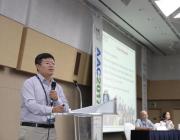摘要:
BACKGROUND: The link between concentrations of particulate matter (PM) and respiratory morbidity has been investigated in numerous studies. OBJECTIVES: The aim of this study was to analyze the role of different particle size fractions with respect to respiratory health in Beijing, China. METHODS: Data on particle size distributions from 3 nm to 1 mu m; PM10 (PM <= 10 mu m), nitrogen dioxide (NO2), and sulfur dioxide concentrations; and meteorologic variables were collected daily from March 2004 to December 2006. Concurrently, daily counts of emergency room visits (ERV) for respiratory diseases were obtained from the Peking University Third Hospital. We estimated pollutant effects in single-and two-pollutant generalized additive models, controlling for meteorologic and other time-varying covariates. Time-delayed associations were estimated using polynomial distributed lag, cumulative effects, and single lag models. RESULTS: Associations of respiratory ERV with NO2 concentrations and 100-1,000 nm-particle number or surface area concentrations were of similar magnitude-that is, approximately 5% increase in respiratory ERV with an interquartile range increase in air pollution concentration. In general, particles <50 nm were not positively associated with ERV, whereas particles 50-100 nm were adversely associated with respiratory ERV, both being fractions of ultrafine particles. Effect estimates from two-pollutant models were most consistent for NO2. CONCLUSIONS: Present levels of air pollution in Beijing were adversely associated with respiratory ERV. NO2 concentrations seemed to be a better surrogate for evaluating overall respiratory health effects of ambient air pollution than PM10 or particle number concentrations in Beijing.附注:
ISI Document Delivery No.: 744BATimes Cited: 47Cited Reference Count: 51Leitte, Arne Marian Schlink, Uwe Herbarth, Olf Wiedensohler, Alfred Pan, Xiao-Chuan Hu, Min Richter, Matthia Wehner, Birgit Tuch, Thomas Wu, Zhijun Yang, Minjuan Liu, Liqun Breitner, Susanne Cyrys, Josef Peters, Annette Wichmann, H. -Erich Franck, UlrichWu, Zhijun/A-7041-2012; hui, wanghui/C-5671-2008; Wiedensohler, Alfred/D-1223-2013; Cyrys, Josef/B-5359-2014; Breitner, Susanne/B-5348-2014; Schlink, Uwe/D-5357-2015; Peters, Annette/A-6117-2011; Wehner, Birgit/C-2650-2014Breitner, Susanne/0000-0002-0956-6911; Schlink, Uwe/0000-0002-3109-9459; Peters, Annette/0000-0001-6645-0985; Cyrys, Josef/0000-0002-2105-8696Deutsche Forschungsgemeinschaft [FR-1417/3-2]; China National Natural Science Foundation [20420130348, 20637020]This research was supported by the Deutsche Forschungsgemeinschaft (FR-1417/3-2) and the China National Natural Science Foundation (20420130348, 20637020).49140Us dept health human sciences public health scienceRes triangle pk